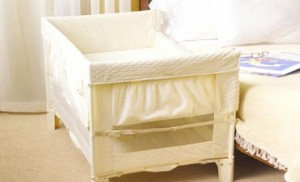Up to 42 percent of parents sleep with their infants at least part of the time, according to Attachment Parenting International. Advances in research have shown that close proximity to parents during sleep is a protective factor against SIDS as well as valuable bonding time.
Whether you’re for or against the idea of the Family Bed, studies show that children who co-sleep with their parents grow up with higher self-esteem and less anxiety. But let’s decipher what’s meant by co-sleeping:
Co-sleeping refers to sleeping in “close proximity,” which means the child is on a separate sleep surface in the same room as the parents. This includes the use of a co-sleeping bassinet or “sidecar,” which is a crib-like bed with only three walls, with the fourth side remaining open and pushed up against the parents’ bed.
The American Academy of Pediatrics (AAP) doesn’t recommend bed sharing with your infant; it recommends having your baby’s crib within an arm’s reach of your bed for safety as well as for ease of breastfeeding and bonding for the first six months.To bed-share safely, place a co-sleeper or bassinet next to your bed, and resist the urge to pull Baby into your bed in the middle of the night when it’s time to breast-feed.
More tips for safe co-sleeping:
• Make sure Baby’s bassinet has a firm, clean surface. Swaddle your baby or use a sleep sack to avoid blankets bunching up and the possibility of a blanket covering Baby’s face.
• Ban air-flow constricting items like Water beds, pillows, sheepskins, stuffed animals and other fluffy materials for Baby
• Remember, baby should only be put down on his back. If you breastfeed in the middle of the night, pulling your infant into your own bed with you, make sure you put the baby back into his bassinet and on his back
• Once your baby is 6 months old, you may prefer to move him into his own room





